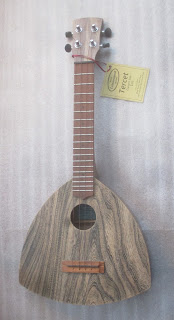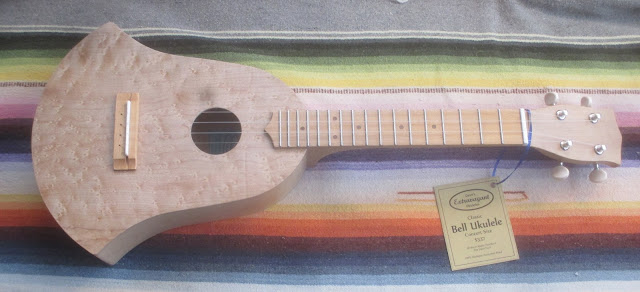What does a ukulele look like? Like a miniature guitar, right? Not necessarily.
Ukulele Manifesto
While most ukuleles look like mini guitars, other popular forms have emerged--the Bell, the Pineapple, the Fluke. The variety may be due to the uke's reputation as a whimsical, "fun" instrument, inspiring non-conformity in design; and the uke's small size makes design experiments cheaper and easier.
For someone like me who likes to design and make things of wood, and who also likes ukulele music, the uke's design possibilities have proven irresistible. I have not been immune to the whimsy factor either. The results, you see here on this blog.
I make ukuleles at 2nd Chance Wood Co. in Durand, MI (https://www.facebook.com/pg/2ndchancewood/posts/?ref=page_internal) . The ukes are made entirely of recycled wood from old Michigan barns and urban reclaimed wood. The instruments are for sale at the 2nd Chance store in Durand, MI. Individuals or dealers may also contact me at raberdavid@yahoo.com.
Monday, February 15, 2021
Tercet Concert Ukulele
Monday, February 8, 2021
Classic Bell Ukulele
The Bell Ukulele was introduced by the Lyon and Healy Co. in the mid-1920s during the "first wave" of the uke's popularity in the US, a time when different companies were vying for sales with some new and different body styles.
I had no idea the bell shape, new and innovative for the ukulele at the time, was based on a shape of another small stringed instrument from "back in the day" in Old Europe--way back in the day, like four centuries back. Looking thru a book on old stringed instruments, I found almost this exact same shape used for a five-string "cittern" from about 1600.
So it appears Lyon and Healy stole this shape from the history books--which is fine, because what would the world of design be like if it wasn't for borrowing (or stealing) from those who came before us? And it would sure be shame if this lovely shape had been lost in history and never brought back to be used again.
I call this ukulele the "Classic" Bell both because it has become a classic design of the 20th Century, and because I went directly back to older classic as well to delineate the shape of my version of the Bell Uke (but it's not that much different from the Lyon and Healy version either).
This one has an almost monochrome light-light color scheme, with a Birdseye Maple top/back, a Maple fretboard, and the other parts of Maple as well. The fretboard, by the way, is made from a strip of old Maple tongue-and-groove flooring, I believe from an old commercial building, or maybe it was a gymnasium.


